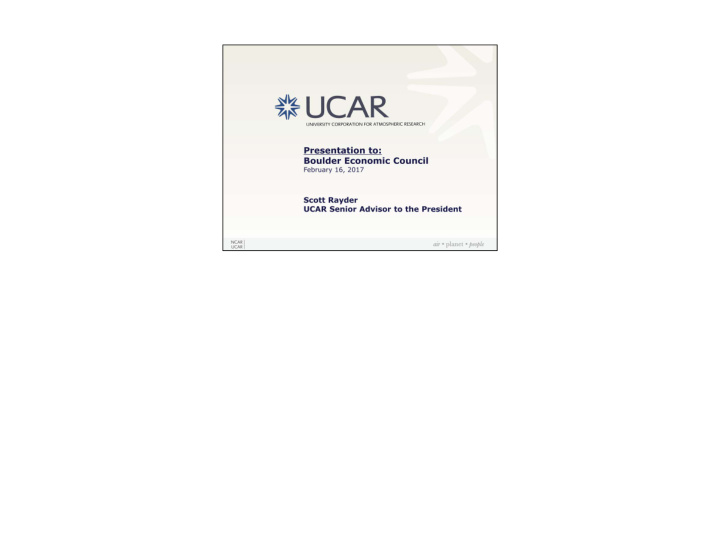



The University Corporation for Atmospheric Research, or UCAR, is a national and international hub for: research education, and advanced technology development UCAR is at the nexus of the weather and climate community. We serve both our university members and support our National Center for Atm ospheric Research through our stewardship of the facility. UCAR also manages a number of com m unity program s designed to support our university colleagues. These include data management, education and outreach and training.
Our strengths: Founded in 1960 , UCAR is a unique consortium of more than 100 member and affiliate institutions (universities that teach and study atmospheric and related science). UCAR manages NCAR on behalf of the National Science Foundation and the university consortium We support the development of some of world ’ s most widely used computer models for understanding weather and climate. Through support from the NSF , we maintain supercomputers, aircraft, and other observing tools that are used by scientists around the globe. • Budget: $200 million • Staff: 1,400 • Locations: Colorado, Wyoming, Hawaii, Washington, D.C.
Our strengths—Research Facilities: We maintain and refine some of the world ’ s most widely used software and models for understanding both weather and climate. Through support from the NSF , we maintain supercomputers, aircraft, and other tools that are used by scientists around the globe. We serve as a place where scientific innovations can evolve from their seeds all the way to applications that improve and enhance our everyday lives.
In order to understand the atmosphere, scientists rely heavily on supercomputing power and observations, plus the software and connectivity to simulate the atmosphere. NCAR is working with university and agency colleagues on specialized computer models to capture: the effects of solar storms on Earth ’ s atmosphere • • the flow of pollutants and other chemicals through the air • the strength and evolution of dangerous weather events such as thunderstorms and hurricanes • the course of regional climate over the next 20 years. NCAR also houses a forecasting test-bed where innovative software for prediction is developed and for use by operational forecasting entities. W hile w e don ’ t issue official forecasts—w e do the research that m akes the forecasts better. This helps to save lives and protecte property in the U.S. and beyond.
One of the nation’s most important weather prediction goals is to extend hurricane forecasts from 5 to 7 days thereby giving communities more time to prepare. MPAS offers potential for longer-term and more accurate forecasts of hurricane tracks, winds and rainfall. When run on high-performance supercomputers, MPAS can simulate weather processes around the global in very fine detail, capturing the development and evolution of individual cloud systems—a long-time goal for researchers and forecasters. MPAS augments regional prediction of hurricanes currently performed with the Weather Research and Forecasting Model (WRF).
CESM is a fully-coupled community, global climate model. It provides state-of-the-art computer simulations of the Earth’s past, present, and future climate states. CESM is sponsored by the NSF and the U.S. Department of Energy.
Recommend
More recommend